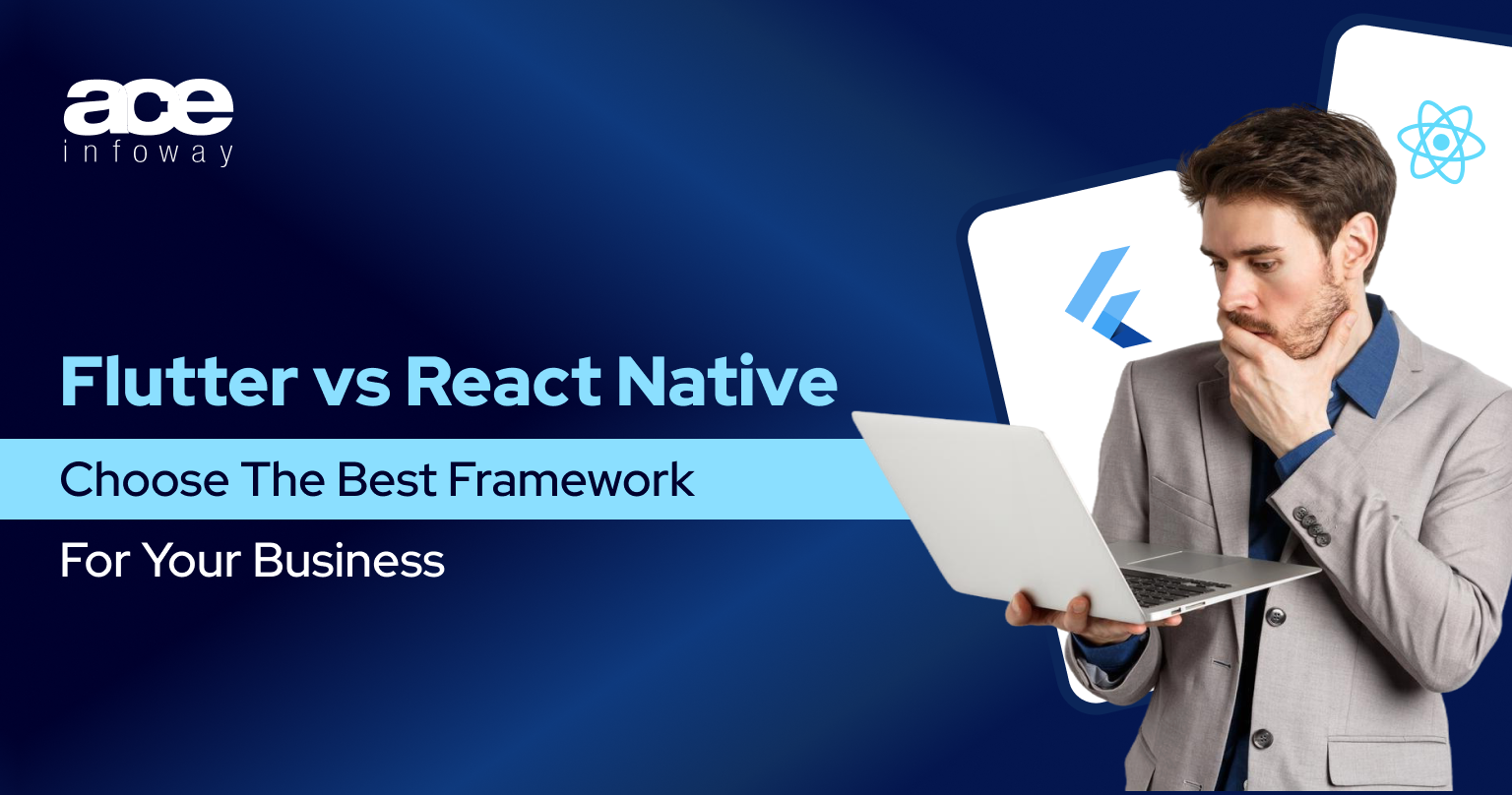Table of Contents
In today’s hyper-competitive mobile market, selecting the right cross-platform framework isn’t just a technical decision. It’s a business-critical decision that can define your product’s success or stall your go-to-market timeline.
With app performance, scalability, and user experience on the line, many teams debate on two major frameworks- Flutter and React Native. This comparison becomes crucial due to the high demand for cross-platform apps.
As more companies race to build unified digital experiences across iOS, Android, and the web, the framework you choose could determine how fast and how far you scale. Both Flutter and React Native promise speed and flexibility. Yet they differ drastically in architecture, developer experience, and ecosystem maturity.
This guide compares Flutter and React Native in 2026, examining aspects such as performance, integration, and long-term scalability, to help you make a confident, future-ready decision. So, without wasting much time, let’s get started.
What is Flutter?
Flutter is Google’s open-source framework designed to help developers build beautiful, high-performance applications for mobile, web, and desktop using a single codebase.
It’s powered by the Dart programming language, also developed by Google, and focuses on delivering a truly native experience across platforms without the hassle of maintaining separate codebases.
Flutter enables you to create consistent, responsive, and visually appealing apps that run seamlessly across Android, iOS, Windows, macOS, and even Linux.
At the core of Flutter lies its widget-based architecture. These widgets act like reusable building blocks that define both the appearance and behaviour of an app. This approach not only makes UI development intuitive but also gives the flutter app development services provider total creative control, similar to how React components work in web development.
Flutter runs on the Flutter Engine, a high-performance runtime written in C++ that integrates with Skia, a powerful 2D graphics rendering library. This combination ensures smooth animations, rich visuals, and lightning-fast rendering.
The engine leverages Dart’s Just-In-Time (JIT) and Ahead-Of-Time (AOT) compilation to deliver fast development cycles and optimal runtime performance.
In the ever-growing debate of Flutter vs React Native, Flutter’s biggest appeal lies in its ability to offer near-native performance with an expressive UI toolkit.
What are the Benefits of Flutter?
1. Cross-Platform Power
Like any strong cross-platform framework, Flutter enables developers to maintain one codebase for multiple platforms, saving both time and resources. It can also be used for Google’s upcoming Fuchsia OS, setting it apart as a future-ready framework.
2. Perfect for MVP Development
If you need to build an app quickly to showcase your idea to investors or test a product concept, Flutter is ideal. You can create high-quality apps that look and feel native on both iOS and Android, all within a fraction of the usual development time.
3. Flexibility and Scalability
Flutter’s flexibility shines through its vast library of customizable widgets. Every update brings enhancements that empower developers to create more tailored and dynamic user experiences, all while maintaining stability and performance.
4. Rich in Built-in Components
Flutter comes packed with everything a developer needs, ranging from rendering engines and navigation tools to testing frameworks and APIs. With built-in support for both Material Design and Cupertino widgets, developers can easily design apps that feel right at home on any platform.
5. Strong Technical Architecture
Unlike many other frameworks, Flutter has most native functionalities baked directly into its engine. This eliminates the need for bridges to communicate with native modules, resulting in faster app performance and reduced development complexity.
Real-world Examples of Flutter
Flutter’s versatility has made it a top choice for global brands:
Google Pay: The redesigned version of Google Pay India was built using Flutter, enabling smooth cross-platform performance with a refined UI.
Alibaba: The e-commerce giant integrated Flutter to enhance parts of their app, improving speed and user experience across devices.
BMW: The “My BMW” app uses Flutter to offer a connected digital experience for drivers, working seamlessly across various platforms.
When comparing Flutter or React Native, Flutter’s ability to combine performance, design flexibility, and scalability makes it a formidable choice for businesses looking to create future-ready applications.
What is React Native?
React Native is an open-source framework created by Meta (formerly Facebook) that empowers developers to build truly native mobile applications using JavaScript and React.
Instead of relying on web technologies like HTML or CSS, React Native taps directly into each platform’s native UI components, creating apps that look, feel, and perform just like those built with native languages.
It’s the perfect blend of web development speed and native performance, a balance that has made it one of the most popular tools in modern app development.
A react native app development services provider can write a single codebase in JavaScript or TypeScript and deploy it across iOS and Android with minimal effort. It even extends to platforms like Windows, macOS, and the web through community-driven projects such as React Native for Web.
That means faster development, easier maintenance, and reduced costs without compromising the end-user experience.
What truly sets React Native apart is its native bridge, the technology that connects JavaScript logic with the device’s native APIs. This bridge allows developers to leverage native performance while still coding in a familiar, flexible environment.
The result? Apps that are visually consistent, incredibly responsive, and built in a fraction of the time traditional development requires.
What are the Benefits of React Native?
1. Optimal Performance
React Native’s architecture enables it to communicate directly with native components, delivering near-native performance levels. Its efficient data handling and precompiled native code execution keep apps stable and responsive, even when handling complex tasks.
2. Code Reusability
One of the framework’s biggest strengths is its ability to reuse up to 90% of the code across different platforms. Developers can even repurpose existing React web app logic, cutting down on repetitive work and accelerating the release cycle.
3. Massive Developer Community
As an open-source platform powered by JavaScript, React Native boasts one of the most active developer communities in the world. This means continuous improvement, countless third-party libraries, and round-the-clock support whenever you hit a roadblock.
4. Clean and Efficient UI
React Native’s component-based architecture ensures apps have sleek, intuitive interfaces with fast load times. Its reactive nature makes UI updates smooth and real-time, required in today’s high-performance applications.
5. Cost-Effective Development
Since React Native allows developers to share code between platforms, companies save big on development and maintenance. There’s no need for separate Android and iOS teams as one skilled team can do it all, faster and more efficiently.
Real-world Examples of React Native
Several global brands have embraced React Native to power their mobile apps:
- Facebook (Meta): As the framework’s creator, Meta uses React Native extensively for features like Facebook Marketplace, optimizing both speed and flexibility.
- Instagram: The platform integrated React Native to deploy features like push notifications faster across both iOS and Android devices.
- Tesla: Tesla’s app, built with React Native, allows users to monitor vehicle performance, check battery status, and manage remote features effortlessly.
When comparing Flutter vs React Native from a business and development perspective, React Native is at the upper hand for its balance of flexibility, speed, and scalability.
Understanding the Core Architectures: React vs Flutter
Before you can decide which framework suits your project best, it’s essential to understand what powers each of them behind the scenes. Architecture defines how a framework interacts with the system, manages UI, and handles performance, all of which directly impact user experience.
While both Flutter and React Native enable developers to build cross-platform apps using a single codebase, their architectural foundations are worlds apart. Let’s discuss the difference between Flutter and React Native’s architecture in detail:
The Architecture of Flutter
Flutter’s architecture revolves around a widget-based system, which forms the backbone of how apps are built. Everything in Flutter, from buttons and text to layouts and animations, is a widget. This modular approach makes UI creation intuitive and highly customizable.
At its core, Flutter uses the Dart programming language, which compiles directly into native ARM code. This means no dependency on bridges or external layers, resulting in lightning-fast performance and smoother animations.
Flutter runs on the Flutter Engine, built with C++ and powered by the Skia graphics library. This combination ensures consistency across platforms, whether your app runs on Android, iOS, web, or desktop.
Key architectural highlights of Flutter:
- Widget-driven design: Everything is built as a widget, allowing for complete design flexibility.
- Native compilation: Dart compiles directly to ARM code for near-native performance.
- Flutter Engine: Manages rendering, text layout, and input handling for all platforms.
- Hot Reload: Enables instant visual feedback without restarting the app.
- Multi-platform support: Build once, deploy across mobile, desktop, and web.
Flutter is best suited for projects that demand high performance, pixel-perfect designs, and visually engaging interfaces. While learning Dart can feel new for some developers, its productivity benefits and performance payoff are hard to ignore.
The Architecture of React Native
React Native follows a completely different design philosophy. Instead of compiling into native code, it relies on a JavaScript bridge to communicate between the JavaScript logic and the device’s native modules.
This architecture allows developers to write app logic using JavaScript or TypeScript while rendering native UI components on each platform. The result? Apps that feel native but are built much faster and maintained more easily.
React Native’s bridge-based model provides the flexibility of web development with the performance of native rendering. However, this bridge layer can sometimes introduce slight performance overhead compared to Flutter’s compiled approach.
Key architectural highlights of React Native:
- JavaScript bridge: Connects JS code with native components for hybrid flexibility.
- Native rendering: Uses real native UI components and not web views.
- Modular architecture: Allows component reuse and easy extension.
- Massive JS ecosystem: Leverages existing JavaScript libraries and frameworks.
- Cross-platform support: Build once for iOS, Android, and beyond (Windows, macOS, web).
React Native’s architecture is ideal for teams familiar with JavaScript and React, making it great for faster prototyping, shorter development cycles, and easy collaboration between web and mobile teams.
So, when it comes to deciding which is better, Flutter or React Native, it really depends on your priorities. Flutter wins on performance and design control, offering a deeply native experience through its compiled approach. React Native, meanwhile, delivers flexibility, speed, and a massive developer ecosystem, which is perfect for teams that want to move fast without reinventing the wheel.
Flutter vs React Native: Which Framework Is Better?
Choosing between Flutter and React Native can feel like picking between two powerful tools built for the same job. Both can deliver stunning, high-performance cross-platform apps, yet they go about it differently. Your choice largely depends on your project goals, team expertise, performance requirements, and timeline.
Why Choose Flutter?
Flutter, Google’s brainchild, uses the Dart language and compiles directly into native code, requiring no bridges or waiting. This gives it a real edge in speed and consistency.
- Lightning-fast performance: Dart compiles ahead of time (AOT), making apps run smoothly across platforms.
- Stunning UI capabilities: Thanks to its widget-based system, developers can craft beautiful, pixel-perfect designs that look identical on both Android and iOS.
- All-in-one rendering engine: Flutter uses Skia, allowing high-quality graphics, fluid animations, and native-level experiences.
- Integrated testing tools: Built-in support for unit, widget, and integration testing ensures quality is maintained.
- Consistent app appearance: Ideal when you want your app to feel exactly the same across devices.
So, does the Flutter app perform as well as native applications? In most cases, yes, its direct compilation and efficient rendering make it nearly indistinguishable from a natively built app.
When to Choose Flutter?
You need a custom UI with intricate animations and visual consistency.
Your project values speed, graphics, and design perfection over quick setup.
You want multi-platform support (iOS, Android, web, and desktop) from a single codebase.
Why Choose React Native?
React Native, backed by Meta, takes a different approach. It bridges JavaScript with native APIs, offering developers the flexibility of web technologies with the feel of a native app.
- JavaScript advantage: Familiarity speeds up development and makes onboarding effortless.
- Massive community: Easier troubleshooting, plenty of libraries, and ongoing support.
- Faster prototyping: Perfect for teams who need to validate ideas quickly.
- Lightweight memory usage: Especially with the Hermes engine, it improves Android performance.
- Strong native integrations: Great for apps needing access to GPS, camera, or other device modules.
React Native’s strong native integrations and JavaScript flexibility make it an excellent choice for rapid app development.
When to Choose React Native?
- Your team already knows JavaScript or React.
- You plan to reuse web components for your mobile app.
- Your app will rely heavily on native device features.
- You need to ship faster and optimize development costs.
Flutter or React Native: What Are The Decision-Making Factors?
Choosing between Flutter and React Native is about what truly fits your app’s goals, team, and future growth. When comparing React vs Flutter, the right choice depends on several factors that influence development speed, scalability, and long-term value.
1. Project Scope & Design Needs
If your app requires sleek visuals, smooth animations, or a uniform UI across Android and iOS, Flutter often shines with its powerful widget system. But when your focus is on rapid deployment and leveraging existing frameworks, React Native takes the lead with its flexibility and faster iteration cycles.
2. Team Skills & Learning Curve
Your team’s existing expertise can heavily influence the decision. Developers with JavaScript experience can quickly adapt to React Native, while teams eager to explore Dart and a more structured development approach may find Flutter more rewarding. Aligning the tech choice with your team’s strengths ensures fewer roadblocks and better productivity.
3. App Maintenance & Future Growth
Long-term sustainability matters as much as the launch itself. Flutter’s single codebase and performance stability reduce maintenance overhead, while React Native benefits from a larger ecosystem and community-driven support.
Both frameworks are reliable, but their significance and impact depend on how you plan to evolve your app over time.
Ultimately, choosing between Flutter and React Native depends on your project’s vision, scalability goals, and tech expertise. Whether you’re building from scratch or planning a Redevelopment Web Portal and Mobile Applications, both frameworks can empower your business with fast, future-ready solutions that deliver a native-like experience.
Conclusion
Which is better, Flutter or React Native? The answer is both. Comparison of Flutter and React Native is a loop discussion; both have their own strengths and weaknesses. When choosing the best framework for you, remember there’s no one-size-fits-all answer.
The choice between Flutter and React Native solely depends on your project needs, business goals, target audience, resources, and the development approach. It is important to choose the best suitable framework wisely. And if you are in any dilemma or have any query, you can reach out to us.
At Ace Infoway, our team of experts guides you in detail and provides you with satisfactory consultation, not just for framework selection but for the entire development cycle and digital transformation.





















